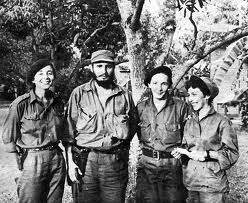28 October 2010
Sierra Maestra Walk | Blog from Cuba: At the birthplace of Celia Sanchez
Friday 22nd October
TODAY we travelled through Granma province, making our way to the historical landing site of the Granma boat. This was the boat commanded by Fidel which set sail from Mexico in 1956 thus beginning the Cuban Revolution.
On our way to the site we had the opportunity to visit the Demajagua the site of Carlos Manuel Cespedes sugar plantation. This was the site from which the first Cuban war of independence from Spain was launched with Cespedes freeing his sugar-cropping slaves encouraging revolt across Cuba against the Spanish ruling classes.
From the Demejagua we proceeded to the birthplace of Celia Sanchez in Manzanillo. Celia was one of the most important ladies of the revolution. She was Fidel’s permanent secretary and right-hand person. The house where she and her family were born has been preserved and transformed into a museum which chronicles her life. For women in particular, Celia is one of the most influential people associated with the 1959 revolution. Her commitment , dedication, intelligence and humanity mark her out as exceptional, a shining example of revolutionary behaviour.
During her time in the Sierra Maestra, Celia planted Mariposa, Roses and Hibiscus. Mariposa, the national flower of Cuba, has become a symbol of Celia and her contribution to the struggle. Celia was strong too. She voluntarily cropped sugar cane by machete along with the men and her yield often surpassed all others.
From Celia Sanchez’s birthplace we made our way to the actual landing site of the Granma boat which Che later described as more of a shipwreck than a landing. There were many reasons for this, as our guide explained.
The Granma was intended to carry 18 passengers; in fact was carrying 82 men from Mexico to Cuba in 1956 along with rifles and ammunition. Also on the voyage from Mexico one of the soldiers fell overboard. Rather than leave a man behind to drown, Fidel spent 6 hours searching for him and saving his life. Weather conditions on the voyage were extremely bad. This necessitated a different, more difficult landing location.
Visiting the site, it was easy for us to appreciate the difficulties facing Fidel and his men on finally landing the boat. Their first task was to chop their way for 6 hours through the dense Mangrove vegetation which they met on the island at the disembarkation site before coming across the house of a local peasant who was willing to help them
– Dale Moore
Follow us on Facebook
An Phoblacht on Twitter
Uncomfortable Conversations

An initiative for dialogue
for reconciliation
— — — — — — —
Contributions from key figures in the churches, academia and wider civic society as well as senior republican figures





